Module 4: Course challenge
Looking answers for ‘analyze data to answer questions course challenge answers’?
In this post, I provide accurate answers and detailed explanations for Module 4: Course challenge of Course 5: Analyze Data to Answer Questions – Google Data Analytics Professional Certificate.
Whether you’re preparing for quizzes or brushing up on your knowledge, these insights will help you master the concepts effectively. Let’s dive into the correct answers and detailed explanations for each question.
1. Scenario 1, Questions 1-7
For the past six months, you have been working for a direct-mail marketing firm as a junior marketing analyst. Direct mail is advertising material sent to people through the mail. These people can be current or prospective customers, clients, or donors. Many charities depend on direct mail for financial support.
Your company, Directly Dynamic, creates direct-mail pieces with its in-house staff of graphic designers, expert mail list services, and on-site printing. Your team has just been hired by a local nonprofit, Food Justice Rock Springs. The mission of Food Justice Rock Springs is to eliminate food deserts by establishing local gardens, providing mobile pantries, educating residents, and more. Click below to read the email from Tayen Bell, vice president of marketing and outreach.
You begin by reviewing the dataset. To use the template for this dataset, click the link below and select “Use Template.”
Link to template: Dynamic Dataset
Or, if you don’t have a Google account, download the file directly from the attachment below.
The client has asked you to send two separate mailings: one to people within 50 miles of Rock Springs; the other to anyone outside that area. So, to research each donor’s distance from the city, you first need to find out where all of these people live.
You could scroll through 209 rows of data, but you know there is a more efficient way to organize the cities.
Which of the following procedures will enable you to sort your spreadsheet by city (Column K) in ascending order? Select all that apply.
- Select A2-R210, then use the drop-down menu to Sort Sheet by Column K from A to Z ✅

- Use the SORT function syntax: =SORT(A2:R210, 11, TRUE) ✅

- Select A2-R210, then use the drop-down menu to Sort Range by Column K from A to Z
- Use the SORT function syntax: =SORT(A2:R210, K, TRUE)
Explanation: To sort the spreadsheet by city in ascending order, you have two options:
- Using the
SORTfunction:=SORT(A2:R210, 11, TRUE), where11refers to Column K (the city column), andTRUEindicates ascending order. - Using the “Sort Sheet” option: Selecting the range A2-R210 and then using the drop-down menu to “Sort Sheet by Column K from A to Z.”
Both methods correctly sort the data by city in ascending order.
2. Scenario 1, continued
You notice that many cells in the city column, Column K, are missing a value. So, you use the zip codes to research the correct cities. Now, you want to add the cities to each donor’s row. However, you are concerned about making a mistake, such as a spelling typo.
Fill in the blank: To add drop-down lists to your worksheet with predetermined options for each city name, you decide to use _____.
- VLOOKUP
- the find tool
- data validation ✅
- the LIST function
3. Scenario 1, continued
Now, you decide to address Tayen’s request to include a handwritten note in the direct-mail piece for anyone who gave at least $100 last year.
Which of the following spreadsheet tools will enable you to change how cells appear if they contain a value of $100 or more?
- Conditional formatting ✅
- The COUNTA function
- The MAX function
- Data validation
4. Scenario 1, continued
At this point, you notice that the information about state and zip code is in the same cell. However, your company’s mailing list software requires states to be on a separate line from zip codes.
To move the 5-digit zip code in cell L2 into its own column, you use the function =LEFT(L2,5).
- True
- False ✅
5. Scenario 1, continued
Next, you duplicate your dataset twice using the Sheet Menu. You rename the first sheet Donation Form List, and you remove the cities that are further than 50 miles from Rock Springs. You rename the second sheet Postcard List, and you remove the cities that are within 50 miles of Rock Springs.
Then, you import these datasets into your company’s mailing list database. In a mailing list database, you create two tables: Donation_Form_List and Postcard_List. You decide to clean the Donation_Form_List first.
Your company’s mailing list software requires units to be on the same line as street addresses. However, they are currently in two separate columns (street_address and unit).
What portion of your SQL statement will instruct the database to combine these two columns into a new column called “address”?
- CONCAT(street_address to unit) AS address
- JOIN(street_address, ” to “, unit) AS address
- CONCAT(street_address, ” to “, unit) AS address ✅
- JOIN(street_address to unit) AS address
6. Scenario 1, continued
Your database contains people who live across Wyoming. However, it’s important to align your in-house data with the data from Food Justice Rock Springs. You also need to separate your data into the two lists: Donation_Form_List and Postcard_List. They will be based on each city’s distance from Rock Springs.
The zip codes are in a column called zip_code. What query do you use to select all data from the Donation_Form_List organized by zip code?
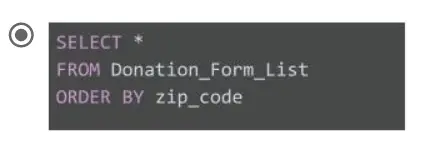
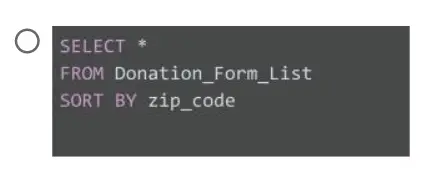
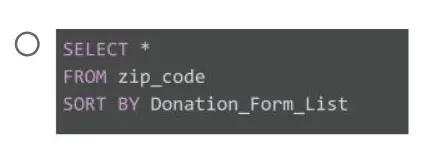
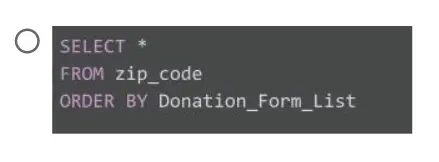
7. Scenario 1, continued
You finish cleaning your datasets, so you decide to review Tayen’s email one more time to make sure you completed the task fully. It’s a good thing you checked because you forgot to identify people who have served on the board of directors or board of trustees. She wants to write them a thank-you note, so you need to locate them in the database.
To retrieve only those records that include people who have served on the board of trustees or on the board of directors, you use the WHERE function. The syntax is:

- True
- False ✅
8. Scenario 2, Questions 8-13
Your company’s direct-mail campaign was very successful, and Food Justice Rock Springs has continued partnering with Directly Dynamic. One thing you’ve been working on is assigning all donors identification numbers. This will enable you to clean and organize the lists more effectively.
Meanwhile, another team member has been creating a prospect list that contains data about people who have indicated interest in getting involved with Food Justice Rock Springs. These people are also assigned a unique ID. Now, you need to compare your donor list with the dataset in your database and collect certain data from both.
What SQL function will return records with matching values in both tables?
- OUTER JOIN
- INNER JOIN ✅
- LEFT JOIN
- RIGHT JOIN
9. Scenario 2, continued
Your next task is to identify the average contribution given by donors over the past two years. Tayen will use this information to set a donation minimum for inviting donors to an upcoming event.
You have performed the calculations for 2019, so now you move on to 2020. To return average contributions in 2020 (contributions_2020), you use the AVG function. You use the following section of a SQL query to find this average and store it in the AvgLineTotal variable:
AVG(contributions_2020) AS AvgLineTotal
- True ✅
- False
10. Scenario 2, continued
Now that you provided her with the average donation amount, Tayen decides to invite 50 people to the grand opening of a new community garden. You return to your New Donor List spreadsheet to determine how much each donor gave in the past two years. You will use that information to identify the 50 top donors and invite them to the event.
What is the correct syntax to add the contribution amounts in cells O2 and P2?
- =SUM(O2*P2)
- =SUM(O2/P2)
- =SUM(“O2,P2”)
- =SUM(O2,P2) ✅

Explanation:
To add the values in cells O2 and P2, you can use the =SUM(O2,P2) formula. This adds the two values together and returns the result.
11. Scenario 2, continued
Tayen informs you that she’s thinking about inviting anyone who donated at least $100 in 2018, as well. However, she only has five open spaces. She asks you to report how many people gave at least $100 so she can determine if they can also be invited to the event.
The correct syntax to count how many donations of $100 or greater appear in Column O is =SUMIF(O2:O210,">=100").
- True
- False ✅
12. Scenario 2, continued
The community garden grand opening was a success. In addition to the 55 donors Food Justice Rock Springs invited, 20 other prospects attended the event. Now, Tayen wants to know more about the donations that came in from new prospects compared to the original donors.
This SQL query can be used to identify the percentage of contributions from prospects compared to total donors:

- True ✅
- False
13. Scenario 2, continued
Your team creates a highly effective prospects list for Food Justice Rock Springs. After a few months, many of these prospects become donors. Now, Tayen wants to know the top three cities in which these new donors live. She will use that information to determine if it’s still true that people who live closer to Rock Springs are more likely to donate.
To retrieve the number of donors in each city, sorted high to low, you use the following query:

- True
- False ✅

Explanation:
The SQL query provided is incorrect because it uses ORDER BY COUNT(DonorID) ASC when it should use ORDER BY COUNT(DonorID) DESC to sort donors in descending order, from highest to lowest count. The correct query should be: SELECT COUNT(DonorID), City FROM new_donor_list GROUP BY City ORDER BY COUNT(DonorID) DESC.
14. Scenario 1, Questions 1-7
For the past six months, you have been working for a direct-mail marketing firm as a junior marketing analyst. Direct mail is advertising material sent to people through the mail. These people can be current or prospective customers, clients, or donors. Many charities depend on direct mail for financial support.
Your company, Directly Dynamic, creates direct-mail pieces with its in-house staff of graphic designers, expert mail list services, and on-site printing. Your team has just been hired by a local nonprofit, Food Justice Rock Springs. The mission of Food Justice Rock Springs is to eliminate food deserts by establishing local gardens, providing mobile pantries, educating residents, and more. Click below to read the email from Tayen Bell, vice president of marketing and outreach.
You begin by reviewing the dataset. To use the template for this dataset, click the link below and select “Use Template.”
Link to template: Dynamic Dataset
Or, if you don’t have a Google account, download the file directly from the attachment below.
The client has asked you to send two separate mailings: one to people within 50 miles of Rock Springs; the other to anyone outside that area. So, to research each donor’s distance from the city, you first need to find out where all of these people live.
You could scroll through 209 rows of data, but you know there is a more efficient way to organize the cities.
Which of the following functions will enable you to sort your spreadsheet by city (Column K) in ascending order?
- =SORT(A2:R210, 11, TRUE) ✅
- =SORT(A2:R210, K, ASC)
- =SORT(A2:R210, K, TRUE)
- =SORT(A2:R210, 11, ASC)
15. Scenario 1, continued
At this point, you notice that the information about state and zip code is in the same cell. However, your company’s mailing list software requires states to be on a separate line from zip codes.
What function do you use to move the 5-digit zip code in cell L2 into its own column?
- =LEFT(L2,5)
- =RIGHT(5,L2)
- =LEFT(5,L2)
- =RIGHT(L2,5) ✅

Explanation:
To extract the 5-digit zip code from Column L, you use the =RIGHT(L2,5) formula. This function takes the rightmost 5 characters from the text in cell L2, which in this case is the zip code.
16. Scenario 1, continued
Next, you duplicate your dataset twice using the Sheet Menu. You rename the first sheet Donation Form List, and you remove the cities that are further than 50 miles from Rock Springs. You rename the second sheet Postcard List, and you remove the cities that are within 50 miles of Rock Springs.
Then, you import these datasets into your company’s mailing list database. In a mailing list database, you create two tables: Donation_Form_List and Postcard_List. You decide to clean the Donation_Form_List first.
Your company’s mailing list software requires units to be on the same line as street addresses. However, they are currently in two separate columns (street_address and unit).
You use a SQL function to instruct the database to combine the two columns into a new column called “address.” The syntax is: JOIN(street_address, " to ", unit) as address.
- True
- False ✅

Explanation:
The syntax to combine the “street_address” and “unit” columns into a new “address” column is CONCAT(street_address, " to ", unit). The JOIN function would not work here because it is used differently in SQL, not for concatenating strings.
17. Scenario 1, continued
You finish cleaning your datasets, so you decide to review Tayen’s email one more time to make sure you completed the task fully. It’s a good thing you checked because you forgot to identify people who have served on the board of directors or board of trustees. She wants to write them a thank-you note, so you need to locate them in the database.
To retrieve only those records that include people who have served on the board of trustees or on the board of directors, what is the correct query?
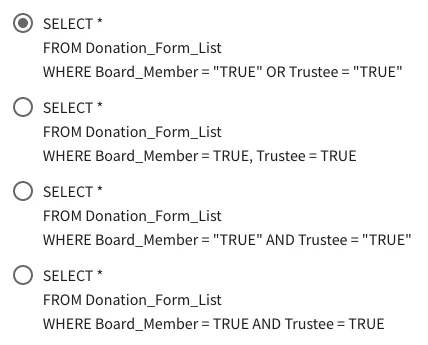

Explanation:
To retrieve records where a person has served on the board of directors or board of trustees, the correct query uses the WHERE clause with OR to include either condition: SELECT * FROM Donation_Form_List WHERE Board_Member = "TRUE" OR Trustee = "TRUE". This will return all records where either condition is true.
18. Scenario 2, Questions 8-13
Your company’s direct-mail campaign was very successful, and Food Justice Rock Springs has continued partnering with Directly Dynamic. One thing you’ve been working on is assigning all donors identification numbers. This will enable you to clean and organize the lists more effectively.
Meanwhile, another team member has been creating a prospect list that contains data about people who have indicated interest in getting involved with Food Justice Rock Springs. These people are also assigned a unique ID. Now, you need to compare your donor list with the dataset in your database and collect certain data from both.
What SQL function will return all records from the left table and only the matching records from the right?
- INNER JOIN
- OUTER JOIN
- LEFT JOIN ✅
- RIGHT JOIN
Explanation:
The correct SQL function for combining data from two tables where all records from the left table and matching records from the right table are returned is LEFT JOIN. This function retrieves all records from the left table and the matched records from the right table, filling in NULL for non-matching rows.
19. Scenario 2, continued
Your next task is to identify the average contribution given by donors over the past two years. Tayen will use this information to set a donation minimum for inviting donors to an upcoming event.
You start with 2019. To return average contributions in 2019 (contributions_2019), you use the AVG function. What portion of your SQL statement will instruct the database to find this average and store it in the AvgLineTotal variable?
- AVG(“contributions_2019”) IN AvgLineTotal
- AVG(contributions_2019) AS AvgLineTotal ✅

- AVG(“contributions_2019”) AS AvgLineTotal
- AVG(contributions_2019) = “AvgLineTotal”
Explanation:
To calculate the average contributions in 2019 and store it in the AvgLineTotal variable, the correct SQL syntax is: AVG(contributions_2019) AS AvgLineTotal. This uses the AVG function to compute the average and assigns it the alias AvgLineTotal.
20. Scenario 2, continued
Tayen informs you that she’s thinking about inviting anyone who donated at least $100 in 2018, as well. However, she only has five open spaces. She asks you to report how many people gave at least $100 so she can determine if they can also be invited to the event.
What is the correct syntax to count how many donations of $100 or great appear in Column O?
- =COUNTIF(02:2010,”<=100”)
- =COUNTIF(O2:O210,”>=100″) ✅

- =SUMIF(02:2010,”>=100”)
- =SUMIF(O2:2010,”>=100″)
Explanation:
The correct formula to count how many donations are $100 or more in Column O is: =COUNTIF(O2:O210,">=100"). COUNTIF is used to count the number of cells that meet the condition (greater than or equal to 100).
21. Scenario 2, continued
The community garden grand opening was a success. In addition to the 55 donors Food Justice Rock Springs invited, 20 other prospects attended the event. Now, Tayen wants to know more about the donations that came in from new prospects compared to the original donors.
Which SQL query can be used to calculate the percentage of contributions from prospects?
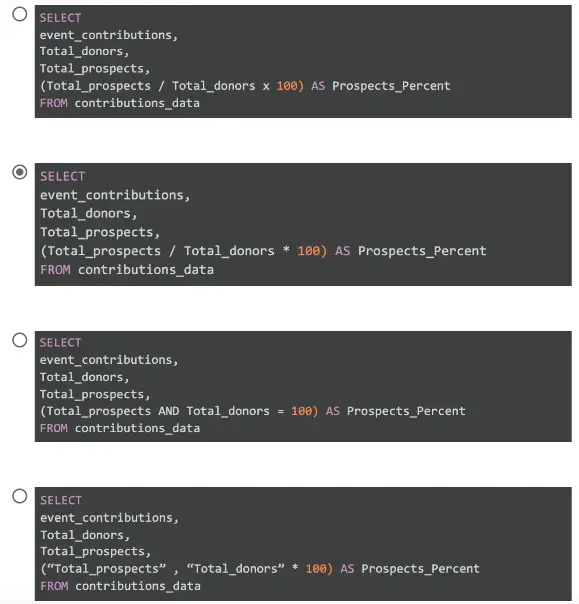

Explanation:
The correct SQL query to calculate the percentage of contributions from prospects is: SELECT event_contributions, Total_donors, Total_prospects, (Total_prospects / Total_donors * 100) AS Prospects_Percent FROM contributions_data. This calculates the percentage of contributions from prospects by dividing the total prospects by the total donors and multiplying by 100.
22. Scenario 2, continued
Your team creates a highly effective prospects list for Food Justice Rock Springs. After a few months, many of these prospects become donors. Now, Tayen wants to know the top three cities in which these new donors live. She will use that information to determine if it’s still true that people who live closer to Rock Springs are more likely to donate.
What clause do you add to the following query to sort the donors in each city from high to low?

- ORDER BY CITY(DonorID) ASC
- ORDER BY COUNT(DonorID) DESC ✅
- ORDER BY CITY(DonorID) DESC
- ORDER BY COUNT(DonorID) ASC
23. Scenario 1, Questions 1-7
For the past six months, you have been working for a direct-mail marketing firm as a junior marketing analyst. Direct mail is advertising material sent to people through the mail. These people can be current or prospective customers, clients, or donors. Many charities depend on direct mail for financial support.
Your company, Directly Dynamic, creates direct-mail pieces with its in-house staff of graphic designers, expert mail list services, and on-site printing. Your team has just been hired by a local nonprofit, Food Justice Rock Springs. The mission of Food Justice Rock Springs is to eliminate food deserts by establishing local gardens, providing mobile pantries, educating residents, and more. Click below to read the email from Tayen Bell, vice president of marketing and outreach.
You begin by reviewing the dataset. To use the template for this dataset, click the link below and select “Use Template.”
Link to template: Dynamic Dataset
Or, if you don’t have a Google account, download the file directly from the attachment below.
The client has asked you to send two separate mailings: one to people within 50 miles of Rock Springs; the other to anyone outside that area. So, to research each donor’s distance from the city, you first need to find out where all of these people live.
You could scroll through 209 rows of data, but you know there is a more efficient way to organize the cities.
Which of the following tools will enable you to sort your spreadsheet by city (Column K) in ascending order?
- Sort Range by Column K from A to Z
- Sort Range by Column K from Z to A
- Sort Sheet by Column K from A to Z ✅
Sort Sheet by Column K from Z to A
24. Scenario 1, continued
Now, you decide to address Tayen’s request to include a handwritten note in the direct-mail piece for anyone who gave at least $100 last year.
Which of the following procedures will enable you to change how cells in your spreadsheet appear if they contain a value of $100 or more?
- Select Column M. Then, select Format > Conditional Formatting. Choose to format cells if they are greater than 100.
- Select Column M. Then, select Format > Conditional Formatting. Choose to format cells if text starts with 100.
- Select Column M. Then, select Format > Conditional Formatting. Choose to format cells if text contains 100.
- Select Column M. Then, select Format > Conditional Formatting. Choose to format cells if they are greater than or equal to 100. ✅

Explanation:
To change the appearance of cells in Column M based on their value, you can use Conditional Formatting. By selecting Column M and applying Conditional Formatting to format cells greater than or equal to 100, you will be able to highlight those cells meeting the criteria (donations of $100 or more).
25. Scenario 1, continued
Your database contains people who live in many areas of Wyoming. However, it’s important to align your in-house data with the data from Food Justice Rock Springs. You also need to separate your data into the two lists: Donation_Form_List and Postcard_List. They will be based on each city’s distance from Rock Springs.
The zip codes are in a column called zip_code. To select all data from the Donation_Form_List organized by zip code, you use the ORDER BY function. The syntax is:

- True ✅

- False
Explanation:
The correct query to select all data from the Donation_Form_List table and order it by the zip code is: SELECT * FROM Donation_Form_List ORDER BY zip_code. This query retrieves all records and sorts them by zip code.
26. Scenario 1, continued
You finish cleaning your datasets, so you decide to review Tayen’s email one more time to make sure you completed the task fully. It’s a good thing you checked because you forgot to identify people who have served on the board of directors or board of trustees. She wants to write them a thank-you note, so you need to locate them in the database.
To retrieve only those records that include people who have served on the board of trustees or on the board of directors, what clause do you include in your query?
- WHERE Board_Member = “TRUE” AND Trustee = “TRUE”
- WHERE Board_Member = “TRUE” OR Trustee = “TRUE” ✅
- WHERE Board_Member = TRUE AND Trustee = TRUE
- WHERE Board_Member = TRUE, Trustee = TRUE
27. Scenario 2, continued
Your team creates a highly effective prospects list for Food Justice Rock Springs. After a few months, many of these prospects become donors. Now, Tayen wants to know the top three cities in which these new donors live. She will use that information to determine if it’s still true that people who live closer to Rock Springs are more likely to donate.
Which SQL query will retrieve the number of donors in each city, sorted high to low?
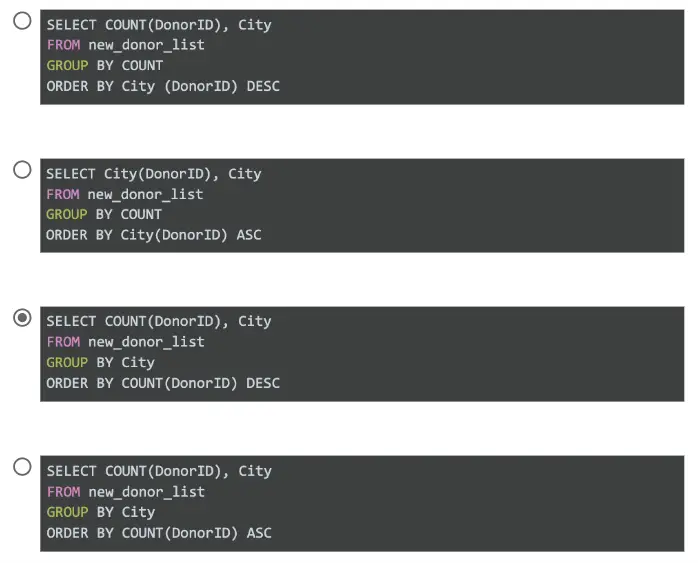
28. Scenario 1, continued
At this point, you notice that the information about state and zip code is in the same cell. However, your company’s mailing list software requires states to be on a separate line from zip codes.
What function will enable you to move the 2-character state abbreviation in cell L2 into its own column?
- =RIGHT(L2,2)
- =RIGHT(2,L2)
- =LEFT(2,L2)
- =LEFT(L2,2) ✅
29. Scenario 1, continued
You notice that many cells in the city column, Column K, are missing a value. So, you use the zip codes to research the correct cities. Now, you want to add the cities to each donor’s row. However, you are concerned about making a mistake, such as a spelling error.
What spreadsheet tool can you use to add a drop-down list with predetermined options for each city name?
- List
- VLOOKUP
- Data validation ✅

- Find
Explanation:
Data validation is the tool used to control what can be entered in a worksheet. By setting up data validation, you can create drop-down lists for predefined options, such as city names, to prevent typos and ensure consistency in data entry.
30. Scenario 1, continued
Your database contains people who live in many areas of Wyoming. However, it’s important to align your in-house data with the data from Food Justice Rock Springs. You also need to separate your data into the two lists: Donation_Form_List and Postcard_List. They will be based on each city’s distance from Rock Springs.
What SQL function do you use to select all data from the Donation_Form_List organized by zip code?
- SEQUENCE
- ORGANIZE
- ARRANGE BY
- ORDER BY ✅
31. Scenario 2, continued
Tayen informs you that she’s thinking about inviting anyone who donated at least $100 in 2018, as well. However, she only has five open spaces. She asks you to report how many people gave at least $100 so she can determine if they can also be invited to the event.
What is the correct syntax to count how many donations of $100 or greater appear in Column O (Contributions 2018)?
- =COUNTIF(O2:O210,”>=100″) ✅
- =COUNTIF(O2:O210>=100)
- =COUNTIF(O2:O210,>=100)
- =COUNTIF(O2:O210″>=100″)
32. Scenario 1, continued
You notice that many cells in the city column, Column K, are missing a value. So, you use the zip codes to research the correct cities. Now, you want to add the cities to each donor’s row. However, you are concerned about making a mistake, such as a spelling typo.
What spreadsheet tool allows you to control what can and cannot be entered in your worksheet in order to avoid typos?
- List
- VLOOKUP
- Find
- Data validation ✅
Related contents:
Module 1: Organize data for more effective analysis
Module 2: Format and adjust data
Module 3: Aggregate data for analysis
Module 4: Perform data calculations
You might also like:
Course 1: Foundations: Data, Data, Everywhere
Course 2: Ask Questions to Make Data-Driven Decisions
Course 3: Prepare Data for Exploration
Course 4: Process Data from Dirty to Clean
Course 6: Share Data Through the Art of Visualization
Course 7: Data Analysis with R Programming
Course 8: Google Data Analytics Capstone: Complete a Case Study

I do not even know how I ended up here, but I thought this post was great.
I do not know who you are but definitely you’re going
to a famous blogger if you aren’t already 😉 Cheers!
I’m glad to hear your words. Thanks for sharing your feedback!